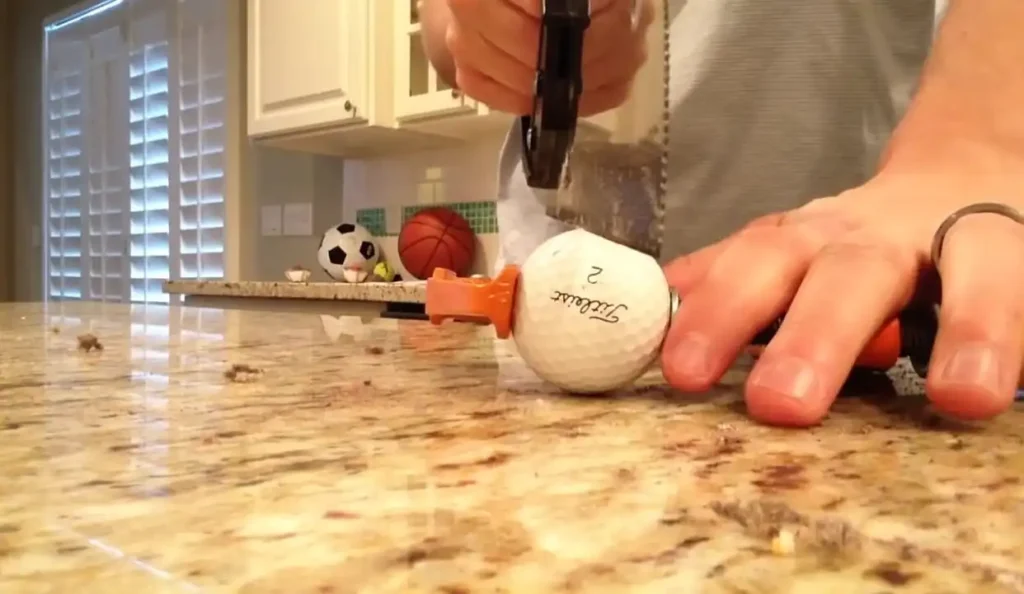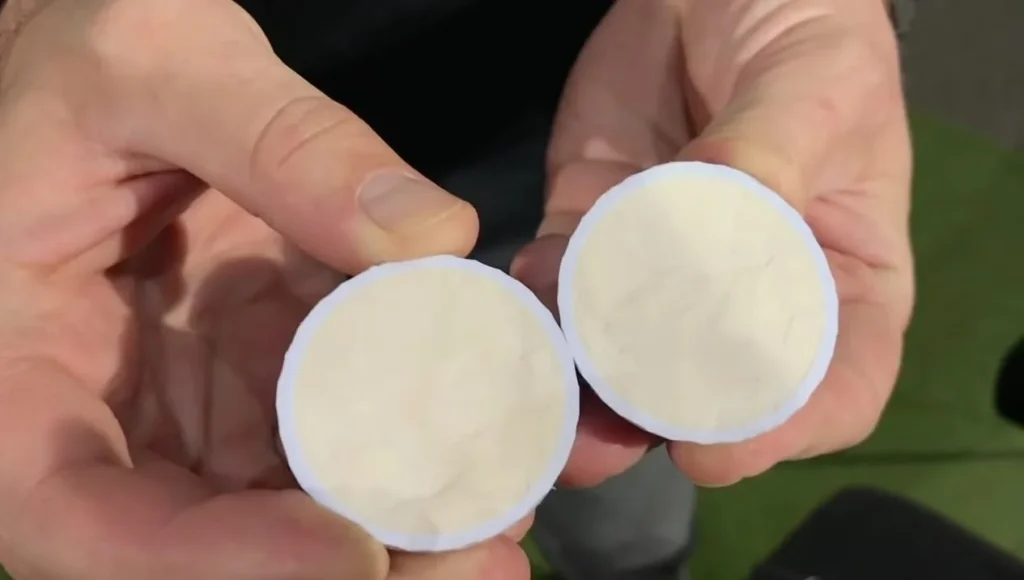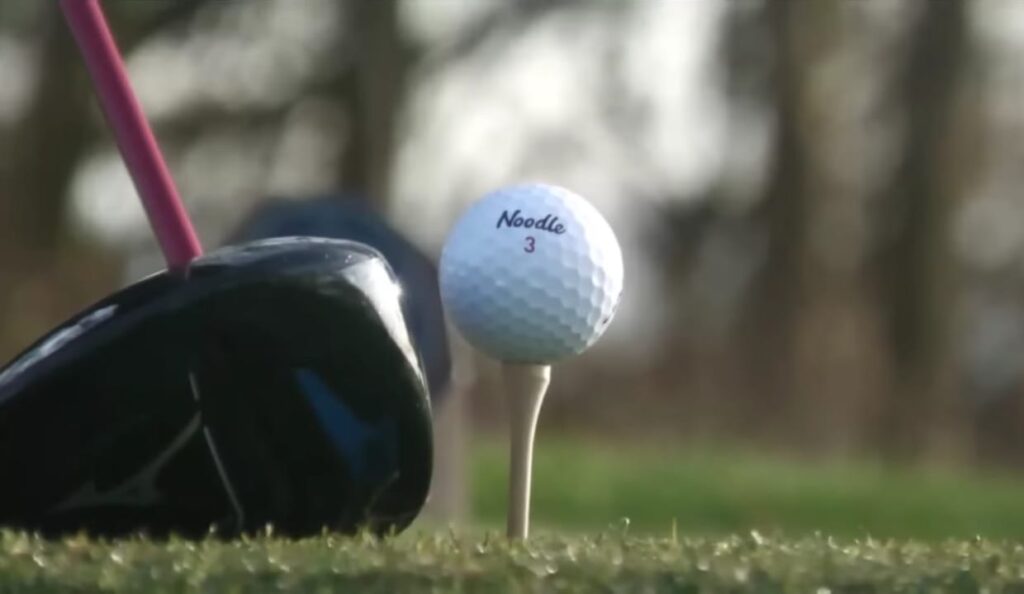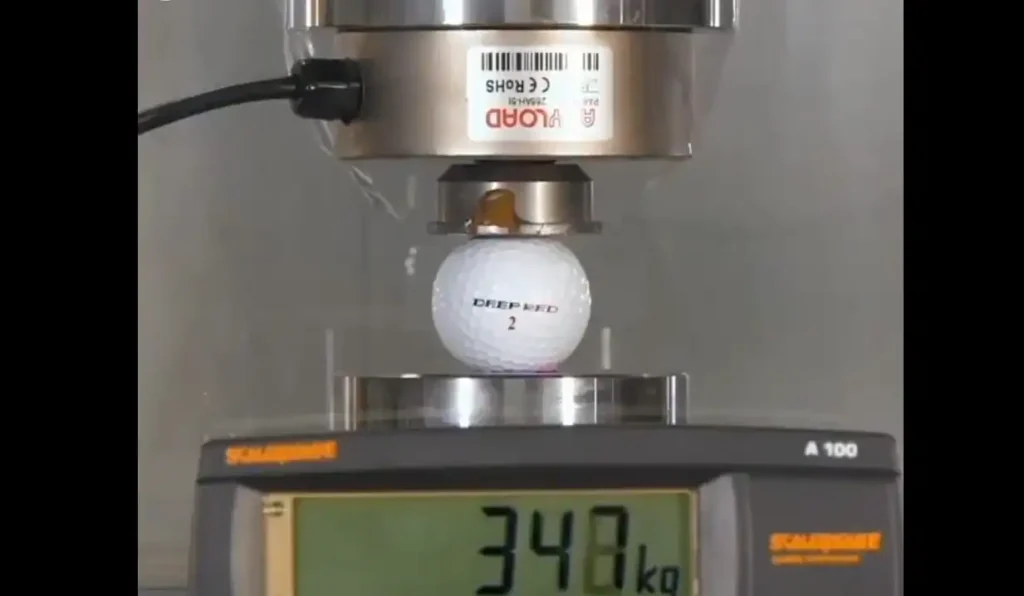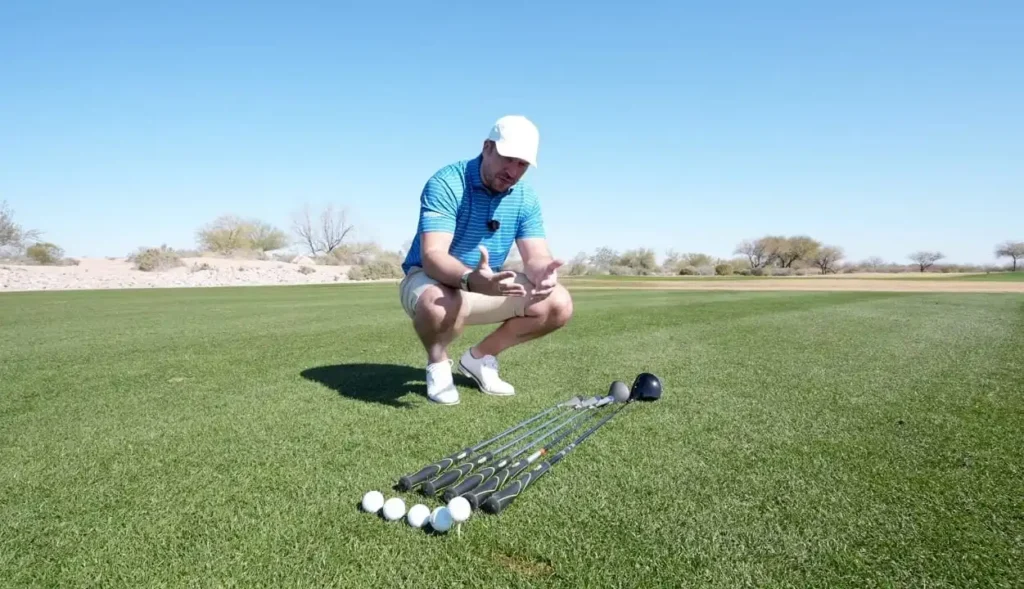When it comes to discussing the world of golf, golf balls are usually the unsung heroes. These small, well-built spheres play a very special role in helping you succeed in a game of golf. There is a fascinating world hidden beneath the surface of your average-looking golf ball. The golf ball core, the golf ball material, and what is inside a golf ball – all these things contribute significantly to improving your golfing skills. So, let’s explore everything inside this tiny sphere. What’s in a golf ball and how is a golf ball made? Let’s answer this question once and for all.

A Brief History of Old Golf Balls
Wooden Golf Balls
At the dawn of golf’s early history, wooden golf balls were common; handcrafted using various species of hardwood, and used by golfers for centuries. As technology advanced within golf itself, so did ball designs. This eventually led to significant variations between today’s manufactured balls and those manufactured during earlier eras. That’s why what is inside a golf ball has changed with time and still depends on the ball’s brand and model.
From Feathers to Modern Marvels
The 14th century saw the development of “feathery” golf balls made with densely packed feathers encased within leather covers. Although these proved an improvement on wooden balls in terms of distance and accuracy, these far fall short today in terms of quality and speed.
Gutta-Percha’s Transformation
The mid-19th century marked an inflection point in golf ball history when gutta-percha was introduced as an innovative material that revolutionized ball design by simplifying mass production while improving performance, becoming immensely popular worldwide as soon as its invention.
Now, you can understand how what’s in a golf ball of the 21st century is significantly different from what’s inside of a golf ball from the early days of this game. In the next section, we will look into how modern golf balls are made and which golf ball material or materials they incorporate.
Modern Golf Balls: A Symphony
Modern golf balls are technological marvels! They’re constructed using various advanced materials designed to optimize different aspects of a player’s game. Understanding the making of these modern balls is important if you wish to maximize performance and maximize results.
Liquid-Center Golf Balls
Liquid-core or liquid-center golf balls represent one of the latest developments in golf ball tech. As their name implies, these innovative balls feature a core filled with liquid, setting them apart from traditional solid-core balls and distinguishing between each one’s composition (which may feature water-based solutions or gel-like substances as filler material for their liquid cores). So, you can idealize what’s in a golf ball of modern makings and how the golf ball core of the early days is different from the one we have today.
At first glance, selecting two-piece or multi-layer golf balls may appear straightforward. After all, there are only two main designs: two-piece and multi-layer. However, core composition plays an essential part in selecting which design best meets your game requirements and we will go into these details so you can make an informed decision.

Two-Piece Golf Ball
Beginners and those with higher handicaps alike often opt for two-piece balls (Zero Friction Spectra Golf Balls) due to their straightforward design: large solid core enclosed by an outer cover encasing it all. Their attractive look ensures maximum distance.
Durability and Affordability
Two-piece golf balls have become widely recognized for both their distance-enhancer capabilities as well as long-term performance, often outlasting multi-layered models in durability tests. Furthermore, two-piece balls tend to be more budget-friendly giving value for your investment. You shouldn’t forget that what’s in a golf ball determines its durability, distance, and affordability; if what is inside a golf ball is costly then the price of the sphere wil skyrocket.
Multi-Layer Golf Ball
At first glance, a multiple-layer golf appears more complex. Comprised of an intricate core construction surrounded by several mantle layers and cover material layers, multi-layered golf balls allow experienced golfers greater control of key aspects such as spin and trajectory.
Tailored Performance
Multi-layer golf balls (Callaway HEX Soft) stand out with their tailored performance thanks to the variety of materials and thicknesses of layers they feature. Offering something perfect for different playing styles like distance, control, or feel of play, multi-layer balls make an exceptional solution.

What’s in a golf ball, you ask?
Let’s find out!
What’s in a golf ball you use every day?
A golf ball is constructed in a complex manner, made up of multiple layers. All these layers serve a specific purpose to optimize the golf ball’s performance. So, here’s a breakdown of what lies inside your everyday golf ball:
Core
The golf ball core is what’s in a golf ball you use daily. This core is made by using materials like synthetic rubber and resin materials. It provides your golf ball with initial velocity upon impact, influecing the golf ball distance. While some golf balls have a solid core, others may have varied cores, such as dual or multiple-layer core.
Mantle layer
Surrounding the golf ball core, lies the mantle layer. This layer helps control the spin rate of your ball and its overall performance. Different brands use different masterials to come up with this layer. Usually, the core and mantle are made of injection-molded rubber of varying densities.
Cover
The outermost layer of the golf ball is the cover, which is typically made from materials like urethane (Srixon Distance) or ionomer (WILSON Staff Duo). The cover plays a crucial role in determining the ball’s feel, durability, and spin control. High-quality urethane covers are often found in premium golf balls, offering exceptional control and greenside performance. So, now you know what’s in a golf ball to play a skillful game in 2024!
Dimples
Dimples are the small, shallow depressions on the surface of the golf ball. They are strategically designed and arranged to optimize the ball’s aerodynamic properties. Dimples create turbulence in the air around the ball, reducing drag and allowing for a stable flight path and maximum distance.
What’s inside of a golf ball made of?
Let’s repeat what’s in a golf ball for your convenience. First, come the golf ball core, made of a few tranditional golf ball material, such as synthetic rubber or resin materials. A mantle layer will surround the golf ball core’ the mantle layer’s materials and design vary from brand to brand. So, you don’t have to worry about that. The outermost layer is typically the cover, made from Urethane or Ionomer. Then every golf ball has multiple dimples i.e., small, shallow depressions designed and placed strategically. A combination of all these components will determine how well your golf ball works. Now, you know exactly what’s in golf balls!
Understanding Your Average Golf Ball
To hit long drives and achieve impressive distances on the golf course, understanding what’s happening with your golf ball is of critical importance. We will look at two essential factors which determine how far away your shots may travel. We’ve looked at what’s in a golf ball and now it’s time to study different factors affecting its performance.
Compression
Ever been fascinated with how different golf balls cover various distances? At its heart lies it’s core’s compression rating, an essential indicator for how energy transfers between clubface and ball and ultimately where it goes.
Density
Along with compression, the density of core material plays a pivotal role in your shot distance. We will examine how variations in density impact its trajectory and roll once it hits the ground. Understanding this factor can help fine-tune your game for optimal performance.
Dimple Patterns
Now let’s turn our focus towards the dimples on a golf ball’s outer surface i.e., its dimples. You might be amazed to discover just how integral these indentations are in controlling how your ball travels through the air. We will explore just how they impact your game. Come explore all that fascinating science can reveal regarding dimple patterns and their influence.

Conclusion
In the past, surgeons used to cut open corposes to see what lurks inside a human body. Today, YouTubers cut open golf-related accessories to see what’s inside of a golf ball. Learning what’s in golf balls can help you appreciate your everyday pieces of golfing equipment much more. We have discussed how the golf ball core is made and which golf ball materials are used to create a masterpiece. Innovation and precision are the guiding blocks of golf ball construction. So, that is how a golf ball makes every shot worth a win!
FAQs – What’s in a Golf Ball?
What do we christen the inside of a golf ball?
A golf ball’s interior consists of three main components i.e., golf ball core, mantle, and cover. Constructed using synthetic rubber for maximum grip at its core area, additional cushion is provided by mantle layers around this core area. Then the cover serves as the outermost layer, completing this triune structure.
What is a golf ball made of in terms of materials?
Golf balls are complex composite objects composed of different materials. Their core is often constructed out of synthetic rubber for its compression and rebound properties; mantle layers may contain various substances designed to further optimize performance; and, finally, their cover material such as Urethane or Surlyn adds durability and tactile feel to their golf balls. These golf ball materials give these spheres their durability.
Which chemicals are used in the making of golf balls
Producing golf balls involves various chemical processes, from polymerization of synthetic rubber core compounds for production through chemical treatments such as Urethane and Surlyn cover materials which undergo specific processes that give specific properties, such as resilience and durability.
Are there rubber bands inside of a golf ball?
No, golf balls do not contain physical rubber bands, however, their cores consist of synthetic rubber which gives them unique compression and rebound characteristics when struck by golfers, impacting how they perform when hit. Now, you know what’s in a golf ball precisely.
Do professional golfers use two-piece or multi-layer balls?
For optimal spin control at higher levels of play, professionals typically opt for multi-layered golf balls due to their superior abilities to alter spin and trajectory. These capabilities are essential in performing at such an elite level of golf performance. It doesn’t matter what’s in golf balls, you should choose one that suits your playing style.
What materials are used to make modern golf balls?
Modern golf balls are made from a combination of synthetic rubber, resin, and plastic. The materials are mixed in specific proportions and shaped into a half-sphere in a mold using a process called compression molding. The core of a golf ball is usually made from polybutadiene (PBD), an artificial rubber. Other substances are added to the PBD to give the core the desired properties, such as zinc diacrylate, which can increase the strength of the rubber.
How do the different layers of a golf ball affect its performance?
The number of layers in a golf ball affects its spin, compression, and distance. Multiple layers result in more spin, while fewer layers result in greater distance. The layers can have different materials and properties. For example, two-piece balls have a thin but tough outer layer that minimizes spin and delivers maximum distance. The ball’s core is the source of its power, and the cover creates resistance that affects the ball’s performance. A thicker cover enhances the ball’s durability and appearance.
Are there environmentally friendly options for golf balls?
Biodegradable golf balls are made from biodegradable materials like plant-based polymers or recycled materials. These balls are biodegradable as they contain no harsh chemicals or compounds. Some biodegradable golf balls are designed to dissolve after a few minutes of submersion. Recycled golf balls are an option for eco-conscious golfers. Some golf ball boxes are designed to be recycled instead of ending up in landfills or oceans.


